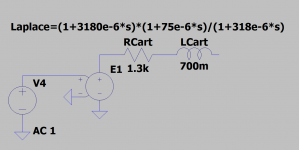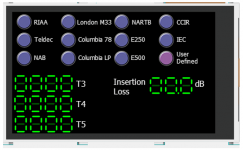You can "effect" the T5 compensation by modifying the input impedance (as long as you know the the cartridge inductance) -- Bob Cordell demonstrated this in an early Linear Audio publication, i.e. VinylTrakI've just been reading about cartridge modelling. You should allow for 50-70k of damping resistance shunting the inductance, as well as some cable capacitance. Wireless World June 1973 p295.
We really shouldn't quibble about any miniscule discrepancies over ~6kHz as there isn't a lot of music information above this frequency in pre-1953 recordings.
I have hundreds of pre-1953 recordings. One of the ideas I have is to record some of the most popular classical discs "flat" and plot the data.
I have hundreds of pre-1953 recordings. One of the ideas I have is to record some of the most popular classical discs "flat" and plot the data.
Hang on a minute. The whole point of the preamp we are discussing is that replay curve differences of up to -20dB at 10KHz are required by pre-RIAA recordings. This is not 'quibbling'. Whatever information is there should be reproduced at the correct level.
Like ejp wrote, a cartridge is much more lossy at high frequencies than an ideal LR series circuit.I should have been more clear, here's how its done in LTSpice. (Although you can do the equations in Excel as well.)
It's the cartridge manufacturer's responsibility to ensure that the response from the record to the voltage across the recommended load impedance is reasonably flat, so when I measure the equalization of a phono amplifier, I deliberately do not include the cartridge impedance.
When determining the noise, I certainly do account for the cartridge impedance, because it much increases the effect of the equivalent input noise current.
If I wanted to see if a non-standard load (with or without inverse resonance filter) gives better results for a given cartridge and stylus, I would need a good test record. billshurv is looking into that sort of thing, as is Nick Sukhov. The disadvantage is that you are either restricted to one specific cartridge and stylus or, with Nick's approach, to an amplifier built into the turntable and a cartridge and stylus with no substantial mechanical resonance.
Anyway, there are separate threads about all of this.
Where does that remaining inaccuracy come from? Some circuit imperfection or is there still something wrong with one of the equations?Calculated dB values at the T4 points using Marcel's R5 in each case show standard deviation of 0.03 dB. In other words all 12 are within 0.1 dB of correct.
I'm all for getting it accurate, but there's not much information on an Edison cylinder above 2-3kHz.Hang on a minute. The whole point of the preamp we are discussing is that replay curve differences of up to -20dB at 10KHz are required by pre-RIAA recordings. This is not 'quibbling'. Whatever information is there should be reproduced at the correct level.
- Home
- Source & Line
- Analogue Source
- Archival Phono Preamp by Gary Galo

